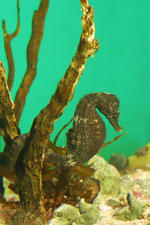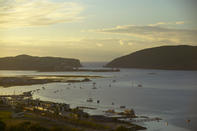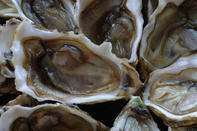Knysna Seahorse

The Knysna Seahorse has only ever occurred in the Knysna estuary, with close cousins in Swartvlei and the estuaries around Plettenberg Bay, but they are now so rare there your chances of seeing Knysna seahorses in the wild are close to zero.
However, the Knysna Seahorse Project has an aquarium at the Knysna quays, where people can learn more about them. Seahorses are actually fishes, with hardened scales. The Knysna species can grow to 13 cm long, and interestingly it’s the males that give birth to the young.
Brenton Blue
The rarest and most highly endangered known creature in South Africa, the Brenton blue is found in Knysna. The Brenton blue was first discovered near Nature's Valley in 1858, but had died out there by the time a second population was discovered on the western Knysna Head in 199.
Then came a property developer who planned to develop the area where the last remaining Brenton blues survived. Eventually he left a 2-ha 'special reserve' for them, and that, just 2 ha of coastal fynbos, is all that stand between them and oblivion.
Knysna Lagoon

The Knysna lagoon is a rich field of study for any scientist. Its bottom varies from a deep mouth to the sea, through deep to shallow channels and mud banks further inland. Over 200 different species of fish flourish in it, including the rare species of sea-horse Hippocampus capensis unique to the estuaries of the Garden route.
The estuary of Knysna River is the least lagoon- or lake-like of any. The mouth is kept permanently open by massive sandstone heads and an immensely strong tidal bore that even salt-encrusted sailors fear. Guarding the entrance to the Knysna Lagoon, the sheer cliffs of The Heads stand astride the narrow passage that has been cut into an ancient marine terrace.
Early attempts to persuade the authorities to ship timber through The Heads were unsuccessful because of the dangers posed by submerged rocks in the narrows. In 1817 the Emu, a Royal Navy brig sent to determine the feasibility of establishing a harbour, struck a rock and ran aground in the entrance.
Over the next 79 years, numerous ships were wrecked or damaged while negotiating the treacherous passage, the last being the Norwegian whaler, Pisang, which capsized in 1914. From below 6 and from the summit of the Eastern Head are views over the lagoon, while the Featherbed Nature Reserve on the slopes of the Western Head is accessible only by joining a cruise on the lagoon.
Knysna Oyster Company

Knysna Lagoon is one of the few places on the South African coast whose water is (so far) sufficiently unpolluted to allow for the cultivation of oysters. At the lagoon end of Long Street, just past Thesen's factory, are the premises of the Knysna Oyster Company. The Knysna Oyster Company was the first South African commercial oyster company that was founded in 1948 to cater to the growing demand for oysters.
From the 1970’s onwards the market for oysters were peaking and provided steady income for families in Knysna, that was still a small fishing town back then. In the 1980’s the first Oyster Festival took place in Knysna to boost tourism during the winter. This created Knysna’s image as ‘oyster headquarters’ of South Africa. The process was quite quite intricate: Finger-nail sized baby oysters, known as spats, were imported from overseas hatcheries.
For two years they would fatten and grow in plastic mesh bags attached to timber racks in the intertidal zone. Then they would be harvested, cleaned and purged in fresh sea water and about 300 tons of them were placed on the market each year. Unfortunately, the company faced various difficulties poor water quality and permit hurdles.
In 2010, the oyster factory’s permit was not renewed and the farms closed down. While Knysna no longer allows the cultivation of oysters in its waters, the Knysna Oyster Company – still trades under its original name and now farms its oysters in Nelson Mandela Bay.
By David Bristow For holiday-makers in search of the dichotomy of relaxation and adventure can rest assured that accommodation in Knysna on the Garden Route ...
For holiday-makers in search of the dichotomy of relaxation and adventure can rest assured that accommodation in Knysna on the Garden Route ... Knysna lies on the banks of a tranquil lagoon, guarded at its mouth by The Heads and overlooked to the north by the Outeniqua Mountains....
Knysna lies on the banks of a tranquil lagoon, guarded at its mouth by The Heads and overlooked to the north by the Outeniqua Mountains....